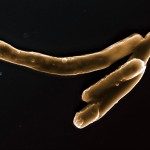Lien vers Pubmed [PMID] – 17655752
BMC Infect. Dis. 2007 Jul;7:83
BACKGROUND: The identification of antigens able to differentiate tuberculosis (TB) disease from TB infection would be valuable. Cellular and humoral immune responses to Erp (Exported repetitive protein)–a recently identified M. tuberculosis protein–have not yet been investigated in humans and may contribute to this aim.
METHODS: We analyzed the cellular and humoral immune responses to Erp, ESAT-6, Ag85B and PPD in TB patients, in BCG+ individuals without infection, BCG+ individuals with latent TB infection (LTBI) and BCG- controls. We used lymphoproliferation, ELISpot IFN-gamma, cytokine production assays and detection of specific human antibodies against recombinant M. tuberculosis proteins.
RESULTS: We included 22 TB patients, 9 BCG+ individuals without TB infection, 7 LTBI and 7 BCG- controls. Erp-specific T cell counts were higher in LTBI than in the other groups. Erp-specific T cell counts were higher in LTBI subjects than TB patients (median positive frequency of 211 SFC/106 PBMC (range 118-2000) for LTBI subjects compared to 80 SFC/106 PBMC (range 50-191), p = 0.019); responses to PPD and ESAT-6 antigens did not differ between these groups. IFN-gamma secretion after Erp stimulation differed between TB patients and LTBI subjects (p = 0.02). Moreover, LTBI subjects but not TB patients or healthy subjects produced IgG3 against Erp.
CONCLUSION: The frequencies of IFN-gamma-producing specific T cells, the IFN-gamma secretion and the production of IgG3 after Erp stimulation are higher in LTBI subjects than in TB patients, whereas PPD and ESAT-6 are not.



